Posts Tagged: autumn
Autumn's Majesty: Tithonia
If there's any flower that should be crowned "Autumn's Majesty," that would be the Mexican sunflower (Tithonia rotundifolia), aka "Torch."A member of...
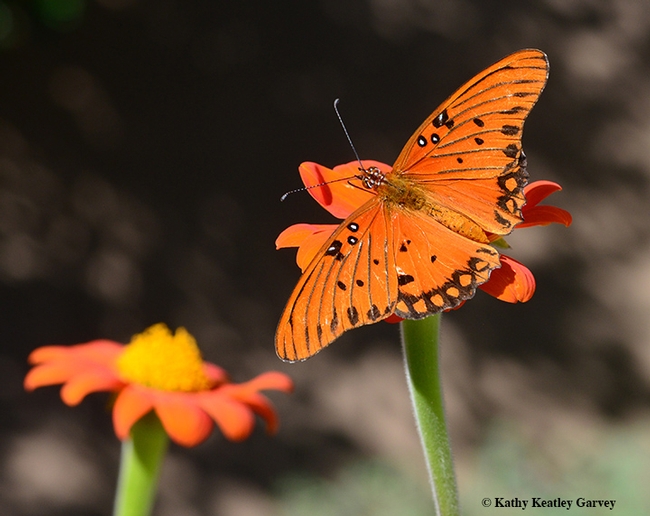
A Gulf Fritillary, Agraulis vanillae, lands on a Mexican sunflower. (Photo by Kathy Keatley Garvey)
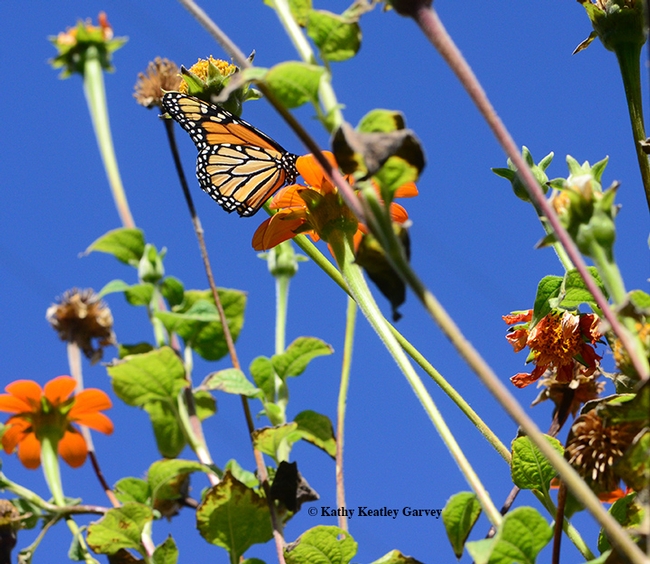
In a sea of nearly spent Mexican sunflowers, a lone migrating monarch, Danaus plexippus, finds food. (Photo by Kathy Keatley Garvey)
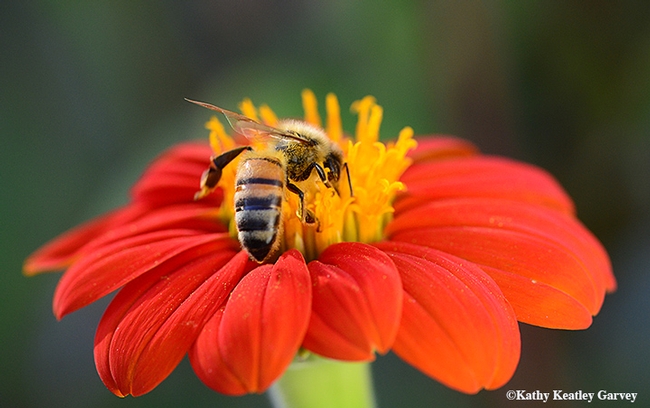
A honey bee, Apis mellifera, takes a liking to the Tithonia, aka Mexican sunflower. (Photo by Kathy Keatley Garvey)
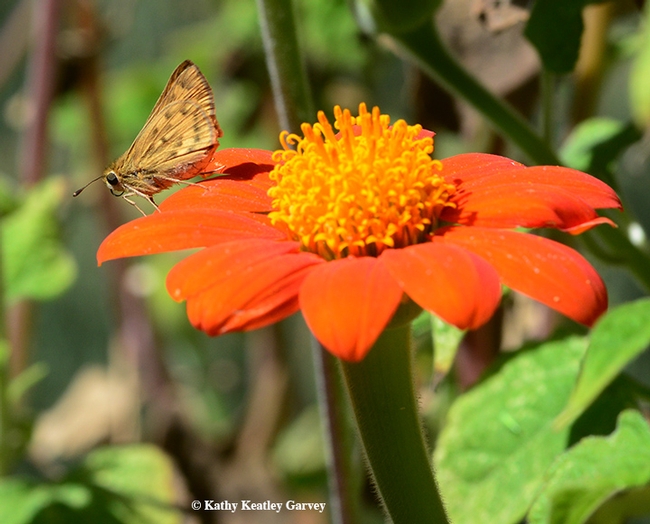
A skipper, family Hesperiidae, hangs out on the Tithonia. (Photo by Kathy Keatley Garvey)
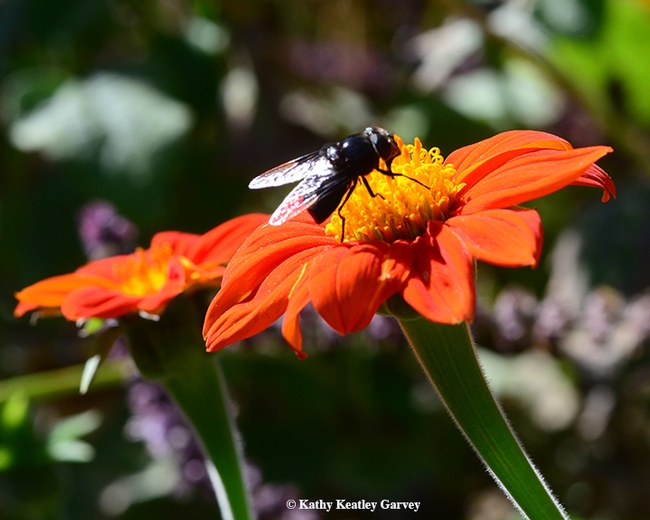
The wings of a black hover fly or syrphid, aka "Mexican cactus fly" (Copestylum mexicanum), gleam in the sunlight. (Photo by Kathy Keatley Garvey)
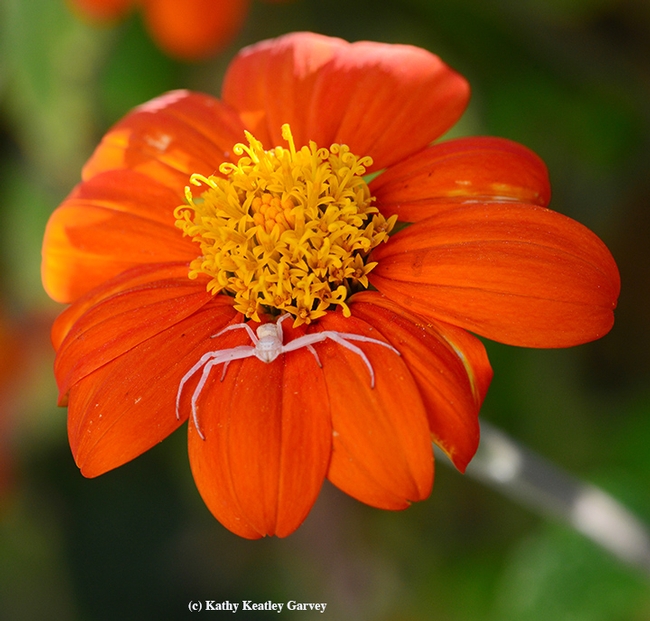
Predators hang out on the Mexican sunflower, too. A crab spider, family Thomisidae, waits for prey. (Photo by Kathy Keatley Garvey)
Keeping Plants in Their Place
Soon it will be time for Autumn Cleanup in the garden. Several years ago, I read in one of my gardening books to not remove the dead leaves of my herbaceous perennials, but to leave them in place to act as insulation from the cold. I am immediately attracted to any advice to avoid work so I was happy to adopt this laissez faire policy. Besides, it made sense that the plant knew what it was doing and cloaking itself in dead leaves must serve some function.
Alas, my perennials were ignorant of geography and did not know that they found themselves in a Mediterranean climate. They spent the winter buried in wet mush and if they did not rot at the crown and die away, they found an alternative strategy to survive. Finding the compacted leaves too difficult to send shoots through, the plants being as lazy as I am chose to sidle sideways like crabs around the garden. If I could have choreographed their movement, I could have had country line dancing plants.
My advice came from gardeners in climates that receive snowfall and leaves or straw would indeed make a cozy bed for plants under snow. But I should have remembered that cold temperatures mean dry conditions also because moisture in the air becomes ice. It just doesn’t get cold enough here to freeze the soil, so dormant plants don’t require insulation.
So remove the dead leaves and if you are going to mulch, keep the mulch away from the crowns of dormant plants. This way, the plant will stay where you put it.

Dieback and emergence of new shoots.
Right Tree, Right Place
As the weather begins to change, I find myself heading outside to garden less and less. This doesn’t mean I don’t have plenty to do to winterize my yard, it simply means the feelings to hibernate are growing stronger. Not going outside, nothing to blog about! PG &E has solved my problem. First, need to backtrack a bit. Behind my home is a dead space that allows PG & E access to power lines, which are about 25-30 ft. from my back fence. About 10 years ago, I planted a very small, Fantasy Maple Tree (Acer freemanii ‘Autumn Fantasy’ Maple). Needless to say, as I look out my kitchen window, I see a gorgeous Maple, about 25 feet tall, with the most impressive show of reddish-purple fall colors. (This variety of maple produces no male flowers so no messy spring clean-up.) I’ve been told I must either cut the tree in half or remove it from my yard. Neither option makes me happy. After much deliberation, I have decided to remove the tree. I’m thinking if it’s not removed, the tree will grow back and I’ll be constantly pruning my Maple. The lesson learned is I should have looked into guidelines for planting near power lines before I chose the Fantasy Maple. On the positive side, PG& E is not only helpful with tree removal but also provides a Guide to Small Trees near power lines for Northern California, a “Right Tree Right Place” publication. This publication offers suggestions for landscaping with small trees, planting guides, tree selection, and tree care. Needless to say, I have a feeling another Autumn Fantasy will be showing up elsewhere in my yard!
See 'em on the Sedum
It's no secret that bees like sedum.The Autumn Joy sedum (family Crassulaceae) growing in our garden is still a tight cluster of broccoli-like...

Honey bee on sedum

Side View

Bottoms Up

